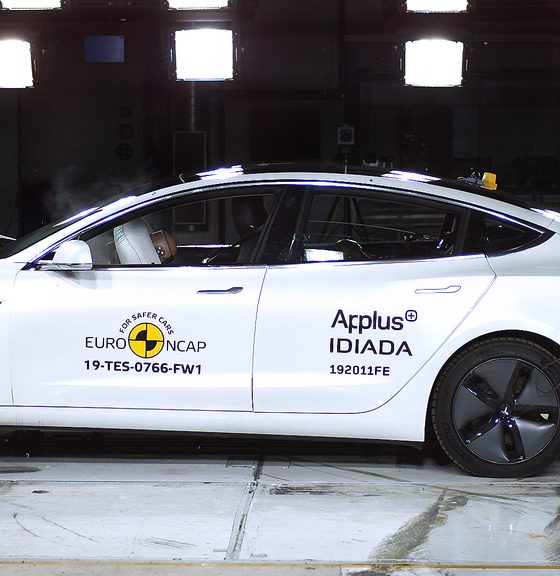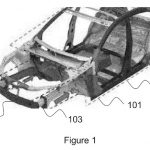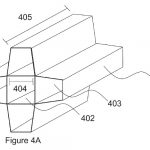

News
Tesla turns up vehicle safety with clever ‘crash can’ patent
Tesla’s electric cars are already among the safest vehicles on the road today with their impressive safety ratings. But even the best cars still have room for improvement, and one can count on Tesla to be the manufacturer that will do what it can to make its already-safe vehicles even safer. An example of this could be found in a recently published patent that describes a “crash can” that can help protect occupants better in the event of a collision.
The patent, titled “ADVANCED THIN-WALLED STRUCTURE FOR ENHANCED CRASH PERFORMANCE” describes a specific design for a “crash can,” a thin-walled metal structure that is built into the crash zones of a vehicle. These metal structures are built to absorb the energy of an impact, and are designed to deform in a stable manner during events such as a crash. Crash cans are typically a square, single-cell tube directly mounted to the front of the frame of the vehicle.
Tesla’s crash can patent takes the same concept but raises it up a couple of notches higher. Instead of using a simple square, single-cell tube, Tesla’s patent describes a “multi-cell structure that includes at least four hollow cuboids.” The four walls of the hollow cuboids meet at 90-degree angles and at least two of the cuboids share a wall. Tesla describes its design in the section below.
“In some embodiments a crash can for a vehicle includes a multi-cell structure that includes a hollow cuboid and four hollow isosceles trapezoidal prisms. The hollow cuboid has four walls and the four hollow isosceles trapezoidal prisms each have a long base, a short base, and two legs. The four hollow isosceles trapezoidal prisms are arranged around the hollow cuboid such that the long base of each hollow isosceles trapezoidal prism shares one of the walls of the hollow cuboid.”
- (Credit: US Patent Office)
- (Credit: US Patent Office)
Illustrations of Tesla’s “crash can” patent. (Credit: US Patent Office)
This updated design, while seemingly a minor change, actually improves the safety of a vehicle during a crash. According to Tesla, the crash can design in its recently-published patent provides a more stable deformation process. This increases the amount of energy that can be absorbed in a collision.
“One advantage of the various embodiments of the crash cans disclosed herein is that the multi-cell structure of the crash cans provides a more stable form of plastic deformation when the crash can is subject to the force of a collision relative to a single cell (tube) structure. Further, the various geometries described herein may further provide more stable plastic deformation relative to conventional geometries. As described herein, plastic deformation is the process of absorbing energy when the crash can is subject to a collision. Various exemplary crash cans provided herein increases plastic deformation, and thus the amount of energy absorbed, by increasing the probability that the crash cans buckle in a progressive manner. Thus, the multi-cell structure of the exemplary crash cans increases the probability that when subjected to axial force the crash cans will buckle in a stable top-down, progressive folding of the structure.
“Increasing plastic deformation in this manner grants the multi-cell crash can several advantages. For example, increasing plastic deformation in turn increases the amount of energy that will be absorbed during a collision, resulting in lower deceleration for the occupant(s) and critical components of a vehicle involved in a collision. This, in turn, results in an overall safer experience for the occupant(s) and critical components, providing for a lower chance of injury or damage. Additionally, increasing the probability that the multi-cell crash can buckles in a stable manner increases the predictability of how the crash can will react when subject to a collision, which in turn increases the predictability of how the rest of the vehicle will react. This allows for greater predictability of what an occupant will experience and allows for more precise planning on how to keep the occupant safe.”
The full text of Tesla’s novel “crash can” patent could be accessed here.
Among the carmakers in the auto segment today, Tesla is arguably the most obsessive when it comes to its vehicles’ safety. Each one of Tesla’s electric cars has performed well in crash tests, with the Model X SUV proving to be near-impossible to topple, and the Model 3 acing the safety tests of the NHTSA, Euro NCAP, ANCAP, and even the IIHS. With improvements such as those described in its recently-published “crash can” patent, Tesla’s electric cars today, as well as its upcoming vehicles, could prove even safer.

News
Elon Musk’s Grokipedia surges to 5.6M articles, almost 79% of English Wikipedia
The explosive growth marks a major milestone for the AI-powered online encyclopedia, which was launched by Elon Musk’s xAI just months ago.

Elon Musk’s Grokipedia has grown to an impressive 5,615,201 articles as of today, closing in on 79% of the English Wikipedia’s current total of 7,119,376 articles.
The explosive growth marks a major milestone for the AI-powered online encyclopedia, which was launched by Elon Musk’s xAI just months ago. Needless to say, it would only be a matter of time before Grokipedia exceeds English Wikipedia in sheer volume.
Grokipedia’s rapid growth
xAI’s vision for Grokipedia emphasizes neutrality, while Grok’s reasoning capabilities allow for fast drafting and fact-checking. When Elon Musk announced the initiative in late September 2025, he noted that Grokipedia would be an improvement to Wikipedia because it would be designed to avoid bias.
At the time, Musk noted that Grokipedia “is a necessary step towards the xAI goal of understanding the Universe.”
Grokipedia was launched in late October, and while xAI was careful to list it only as Version 0.1 at the time, the online encyclopedia immediately earned praise. Wikipedia co-founder Larry Sanger highlighted the project’s innovative approach, noting how it leverages AI to fill knowledge gaps and enable rapid updates. Netizens also observed how Grokipedia tends to present articles in a more objective manner compared to Wikipedia, which is edited by humans.
Elon Musk’s ambitious plans
With 5,615,201 total articles, Grokipedia has now grown to almost 79% of English Wikipedia’s article base. This is incredibly quick, though Grokipedia remains text-only for now. xAI, for its part, has now updated the online encyclopedia’s iteration to v0.2.
Elon Musk has shared bold ideas for Grokipedia, including sending a record of the entire knowledge base to space as part of xAI’s mission to preserve and expand human understanding. At some point, Musk stated that Grokipedia will be renamed to Encyclopedia Galactica, and it will be sent to the cosmos.
“When Grokipedia is good enough (long way to go), we will change the name to Encyclopedia Galactica. It will be an open source distillation of all knowledge, including audio, images and video. Join xAI to help build the sci-fi version of the Library of Alexandria!” Musk wrote, adding in a later post that “Copies will be etched in stone and sent to the Moon, Mars and beyond. This time, it will not be lost.”
News
Tesla Model 3 becomes Netherlands’ best-selling used EV in 2025
More than one in ten second-hand electric cars sold in the country last year was a Tesla Model 3.

The Tesla Model 3 became the most popular used electric car in the Netherlands in 2025, cementing its dominance well beyond the country’s new-car market.
After years at the top of Dutch EV sales charts, the Model 3 now leads the country’s second-hand EV market by a wide margin, as record used-car purchases pushed electric vehicles further into the mainstream.
Model 3 takes a commanding lead
The Netherlands recorded more than 2.1 million used car sales last year, the highest level on record. Of those, roughly 4.8%, or about 102,000 vehicles, were electric. Within that growing segment, the Tesla Model 3 stood far ahead of its competitors.
In 2025 alone, 11,338 used Model 3s changed hands, giving the car an 11.1% share of the country’s entire used EV market. That means more than one in ten second-hand electric cars sold in the country last year was a Tesla Model 3, Auto Week Netherlands reported. The scale of its lead is striking: the gap between the Model 3 and the second-place finisher, the Volkswagen ID3, is more than 6,700 vehicles.
Rivals trail as residual values shape rankings
The Volkswagen ID.3 ranked a distant second, with 4,595 used units sold and a 4.5% market share. Close behind was the Audi e-tron, which placed third with 4,236 registrations. As noted by Auto Week Netherlands, relatively low residual values likely boosted the e-tron’s appeal in the used market, despite its higher original price.
Other strong performers included the Kia Niro, the Tesla Model Y, and the Hyundai Kona, highlighting continued demand for compact and midsize electric vehicles with proven range and reliability. No other model, however, came close to matching the Model 3’s scale or market presence.
News
Tesla Model Y Standard Long Range RWD launches in Europe
The update was announced by Tesla Europe & Middle East in a post on its official social media account on X.

Tesla has expanded the Model Y lineup in Europe with the introduction of the Standard Long Range RWD variant, which offers an impressive 657 km of WLTP range.
The update was announced by Tesla Europe & Middle East in a post on its official social media account on X.
Model Y Standard Long Range RWD Details
Tesla Europe & Middle East highlighted some of the Model Y Standard Long Range RWD’s most notable specs, from its 657 km of WLTP range to its 2,118 liters of cargo volume. More importantly, Tesla also noted that the newly released variant only consumes 12.7 kWh per 100 km, making it the most efficient Model Y to date.
The Model Y Standard provides a lower entry point for consumers who wish to enter the Tesla ecosystem at the lowest possible price. While the Model 3 Standard is still more affordable, some consumers might prefer the Model Y Standard due to its larger size and crossover form factor. The fact that the Model Y Standard is equipped with Tesla’s AI4 computer also makes it ready for FSD’s eventual rollout to the region.
Top Gear’s Model Y Standard review
Top Gear‘s recent review of the Tesla Model Y Standard highlighted some of the vehicle’s most notable features, such as its impressive real-world range, stellar infotainment system, and spacious interior. As per the publication, the Model Y Standard still retains a lot of what makes Tesla’s vehicles well-rounded, even if it’s been equipped with a simplified interior.
Top Gear compared the Model Y Standard to its rivals in the same segment. “The introduction of the Standard trim brings the Model Y in line with the entry price of most of its closest competition. In fact, it’s actually cheaper than a Peugeot e-3008 and costs £5k less than an entry-level Audi Q4 e-tron. It also makes the Ford Mustang Mach-E look a little short with its higher entry price and worse range,” the publication wrote.










